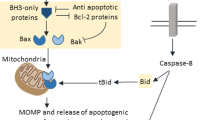Abstract
Single-strand DNase and poly rAase, activities characteristic of endo-exonuclease, were co-activated in nuclear fractions of HL-60 cells by caspase-3. Activation was accompanied by cleavages of large soluble polypeptides (130–185 kDa) and a 65 kDa inactive chromatin-associated polypeptide related to the endo-exonuclease of Neurospora crassa as detected on immunoblots. The major products seen in vitro were a 77 kDa soluble polypeptide and an active chromatin-associated 34 kDa polypeptide. When HL-60 cells were induced to undergo apoptosis by treating with 50 μM etoposide (VP-16) for 4 hours, 77 kDa and 40 kDa polypeptides accumulated in nuclear fractions. Chromatin DNA fragmentation activity was also activated in cytosol and nuclear extract either by pre-treating the cells in vivo with VP-16 or by treating the cytosol in vitro with caspase-3 or dATP and cytochrome c. Endo-exonuclease activated by caspase-3 in cytosol-derived fractions augmented chromatin DNA fragmentation activity in vitro. Endo-exonuclease is proposed to act in vivo in conjunction with the caspase-activated DNase (CAD) to degrade chromatin DNA during apoptosis of HL-60 cells.
Similar content being viewed by others
References
Walker PR, Pandey S, Sikorska M. Degradation of chromatin in apoptotic cells. Cell Death Differ 1995; 2: 93–100.
Fraser MJ, Low RL. Fungal and mitochondrial nucleases. In: Roberts RJ, Linn SM, Lloyd RS, eds. Nucleases, 2nd Ed. Cold Spring Harbor Laboratory Press 1993: 171–207.
Fraser MJ. Endo-exonucleases: Actions in the life and death of cells. Bioscience Report. R. G. Landes Co.1996: 1–73.
Ramotar D, Auchincloss AH, Fraser MJ. Nuclear endoexonuclease of Neurospora crassa: Evidence for a role in DNA repair. J Biol Chem 1987; 262: 425–431.
Fraser MJ, Tynan SJ, Papaioannou A, Ireland CM, Pittman SM. Endo-exonuclease of human leukaemic cells: Evidence for a role in apoptosis. J Cell Sci 1996; 109: 2343–2360.
Chow T-YK, Fraser MJ. Purification and properties of single strand DNA-binding endo-exonuclease of Neurospora crassa. J Biol Chem 1983; 258: 12010–12018.
Fraser MJ, Hatahet Z, Huang X. The actions of Neurospora endo-exonuclease on double strand DNAs. J Biol Chem 1989; 264: 13093–13101.
Hatahet Z, Fraser MJ. Specific inhibitors of Neurospora endoexonuclease. Biochem Cell Biol 1989; 67: 632–641.
Couture C, Chow T-YK. Purification and characterization of a mammalian endo-exonuclease. Nucl Acids Res 1992; 20: 4355–4361.
Chow T-YK, Resnick MA. Purification and characterization of an endo-exonuclease from Saccharomyces cerevisiae that is influenced by the RAD52 gene. Mol Gen Genet 1988; 211: 41–48.
Asefa B, Kauler P, Cournoyer D, Lehnert S, Chow TY-K. Genetic analysis of the yeast NUD1 endo-exonuclease: A role in the repair of DNA double strand breaks. Curr Genet1998; 34: 360–367.
Enari M, Sakahira H, Yokoyama K, Iwamatsu A, Nagata S. A caspase-activated DNase that degrades DNA during apoptosis, and its inhibitor ICAD. Nature 1998;391: 43–50.
Sakahira H, Enari M, Nagata S. Cleavage of CAD inhibitor in CAD activation and DNA degradation during apoptosis. Nature 1998; 391: 96–99.
Liu X, Zou H, Slaughter C, Wang X. DFF, a heterodimeric protein that functions downstream of caspase-3 to triggerDNA fragmentation during apoptosis. Cell 1997; 89: 175–184.
Liu X, Li P, Widlak P, et al. The 40-kDa subunit of DNA fragmentation factor induces DNA fragmentation and chromatin DNA condensation during apoptosis. Proc Natl Acad Sci USA 1998; 95: 8461–8466.
McIlroy D, Sakahira H, Talanian RV, Nagata S. Involvement of caspase-3-activated DNase in internucleosomal DNA cleavage induced by diverse apoptotic stimuli. Oncogene 1999; 18: 4401–4408.
Mukae N, Enari M, Sakahira H, et al. Molecular cloning and characterization of human caspase-activated DNase. Proc Natl Acad Sci USA 1998; 95; 9123–9128.
Halenbeck R, MacDonald H, Roulston A, Chen TT, Conroy L, Williams LT. CPAN, a human nuclease regulated by the caspase-sensitive inhibitor DFF45. Curr Biol 1998; 8: 537–540.
Kawane K, Fukuyama H, Adachi M, et al. Structure and promoter analysis of murine CAD and ICAD genes. Cell Death Differ 1999; 6: 745–752.
Samejima K, Earnshaw WC. ICAD/DFF regulator of apoptotic nuclease is nuclear. Exptl Cell Res 1998; 243: 453–459.
Bonner C, Monney, L. Apoptosis without caspases: An ineffi-cient molecular guillotine? Cell Death Differ 1999; 6: 497–507.
Martins LM, KottkeT, MesnerPW, et al. Activation of multiple interleukin-1¯ converting enzyme homologues in cytosol and nuclei of HL-60 cells during etoposide-induced apoptosis. J Biol Chem 1997; 272: 7421–7430.
Meng XW, Fraser MJ, Feller JM, Ziegler JB. Caspase-3-dependent and caspase-3-independent pathways leading to chromatin DNA fragmentation in HL-60 cells. Apoptosis2000; 5: 57–63.
Yoshida A, Pourquier P, Pommier Y.Purification and characterization of a Mg2+-dependent endonuclease (AN34) from etoposide-treated human leukemia HL-60 cells undergoing apoptosis. Cancer Res 1998; 58: 2576–2582.
Saeki K, Akira Y, Kato M, Miyazono K, Yakazaki Y, Takaku F. Cell density-dependent apoptosis in HL-60 cells, which is mediated by an unknown soluble factor, is inhibited by transforming growth factor ¯1 and overexpression of Bcl-2. J Biol Chem 1997; 272: 20003–20010.
Fraser MJ, ChowT-YK, Cohen H, Koa H. An immunochemical study of Neurospora nucleases. Biochem Cell Biol 1986; 64: 106–116.
Meng XW, Fraser MJ, Ireland CM, Feller JM, Ziegler JB. An investigation of a possible role for mitochondrial nuclease in apoptosis. Apoptosis 1998; 3: 395–406.
Samejima K, Tone S, Kottke TJ, et al. Transition from caspasedependent to caspase-independent mechanisms at the onset of apoptosis. J Cell Biol 1998; 143: 225–239.
Liu X, Kim CN, Yang J, Jemmerson R, Wang X. Induction of apoptotic program in cell-free extracts: Requirement for dATP and cytochrome c. Cell 1996; 86: i147–157.
Zhivotovsky B, Gahm A, Ankarcrona M, Nicotera P, Orrenius S. Multiple proteases are involved in thymocyte apoptosis. Exper Cell Res 1995; 221: 404–412.
Fearnhead HO, Rivett AJ, Dinsdale D, Cohen GM. A preexisting protease is a common effector of thymocyte apoptosis mediated by diverse stimuli. Febs Lett 1995; 357: 242–246.
Dake E, Hofmann TJ, McIntire S, Hudson A, Zassenhaus HP. Purification and properties of the major nuclease from mitochondria of Saccharomyces cerevisiae. J Biol Chem 1988; 263: 7691–7702.
Author information
Authors and Affiliations
Rights and permissions
About this article
Cite this article
Meng, X.W., Fraser, M.J., Feller, J.M. et al. Caspase-3 activates endo-exonuclease: Further evidence for a role of the nuclease in apoptosis. Apoptosis 5, 243–254 (2000). https://doi.org/10.1023/A:1009604529237
Issue Date:
DOI: https://doi.org/10.1023/A:1009604529237




